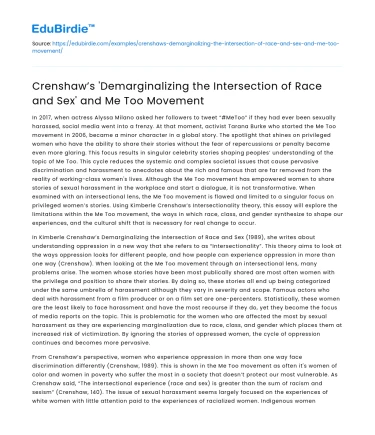In 2017, when actress Alyssa Milano asked her followers to tweet “#MeToo” if they had ever been sexually harassed, social media went into a frenzy. At that moment, activist Tarana Burke who started the Me Too movement in 2006, became a minor character in a global story. The spotlight that shines on privileged women who have the ability to share their stories without the fear of repercussions or penalty became even more glaring. This focus results in singular celebrity stories shaping peoples’ understanding of the topic of Me Too. This cycle reduces the systemic and complex societal issues that cause pervasive discrimination and harassment to anecdotes about the rich and famous that are far removed from the reality of working-class women's lives. Although the Me Too movement has empowered women to share stories of sexual harassment in the workplace and start a dialogue, it is not transformative. When examined with an intersectional lens, the Me Too movement is flawed and limited to a singular focus on privileged women’s stories. Using Kimberle Crenshaw’s Intersectionality theory, this essay will explore the limitations within the Me Too movement, the ways in which race, class, and gender synthesize to shape our experiences, and the cultural shift that is necessary for real change to occur.
In Kimberle Crenshaw’s Demarginalizing the Intersection of Race and Sex (1989), she writes about understanding oppression in a new way that she refers to as “Intersectionality”. This theory aims to look at the ways oppression looks for different people, and how people can experience oppression in more than one way (Crenshaw). When looking at the Me Too movement through an intersectional lens, many problems arise. The women whose stories have been most publically shared are most often women with the privilege and position to share their stories. By doing so, these stories all end up being categorized under the same umbrella of harassment although they vary in severity and scope. Famous actors who deal with harassment from a film producer or on a film set are one-percenters. Statistically, these women are the least likely to face harassment and have the most recourse if they do, yet they become the focus of media reports on the topic. This is problematic for the women who are affected the most by sexual harassment as they are experiencing marginalization due to race, class, and gender which places them at increased risk of victimization. By ignoring the stories of oppressed women, the cycle of oppression continues and becomes more pervasive.
Save your time!
We can take care of your essay
- Proper editing and formatting
- Free revision, title page, and bibliography
- Flexible prices and money-back guarantee
From Crenshaw’s perspective, women who experience oppression in more than one way face discrimination differently (Crenshaw, 1989). This is shown in the Me Too movement as often it's women of color and women in poverty who suffer the most in a society that doesn’t protect our most vulnerable. As Crenshaw said, “The intersectional experience (race and sex) is greater than the sum of racism and sexism” (Crenshaw, 140). The issue of sexual harassment seems largely focused on the experiences of white women with little attention paid to the experiences of racialized women. Indigenous women are three times more likely to be sexually assaulted than non-Indigenous women (Prochuck & Govender, 2018) and one in four black women will be sexually harassed before the age of eighteen (Statistics of Black Women and Assault, 2018). These are usually the women who are forced to keep on enduring harassment so as not to lose their jobs, not the women we are seeing in the media who are harassed when working on movie sets. Although these stories of harassment vary, when women declare “Me Too” they are self-identifying as victims, which is a brave act and deserving of support but it is just the first step in a long process.
Me Too as a movement creates conversations between people and provides an outlet for people to share their stories of harassment. Although it has incredible potential, it does not address the systemic issues that allow abuses of power and sexual harassment to flourish. This demonstrates the real danger of a hashtag that doesn’t lead to policy and legislation changes. In order for a real cultural shift to occur, education on many topics is necessary. Men and boys need to be taught about human rights, equity, consent, and the implications of inappropriate behavior. Corporations need to ensure that policy is in place to create workplace cultures in which harassment can’t occur and labor law needs to be enacted to protect workers’ rights. People need to consider intersectionality in all forms and how certain people are affected more than others. After analyzing Crenshaw’s Demarginalizing the Intersection of Race and Sex (1989) the importance of recognizing intersectionality in our everyday lives, proves to be an ideal way to an equal-focused society. As a society, we need to be as upset about the working experiences of a racialized cashier working at Tim Horton’s as we are about a Hollywood actress working on a film set.






 Stuck on your essay?
Stuck on your essay?

